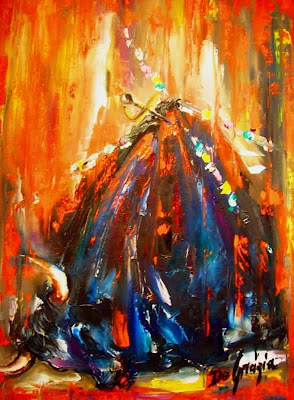The mass has come forward, leaving the hind quarters
disproportionately small and light. His mass, his essence, is
centralized in the great hump of muscle located just behind
the head, the morillo, the focus of all his tension when he is
aroused and enraged. When he enters the ring he sees
and hears the noise of the spectators. He smells the horses,
sees the picadors. The matadors. Two engage in a last
elegant dance whose outcome grows increasingly obvious.
When the last charge finally comes, the bull's head is low,
his eye locked to the muleta, tail held straight out.
And the matador leans in, he leans far in over the horns,
following the sword as it finds its way home in the estocade.
The black tail flips around at the instant when his
pounding heart is burst. The colorful banderillas dangle
from the sagging morillo now. Dark red blood spills down
from his puncture wounds, and the blood is all over
the matador's belly as well.
The swirl of dust particles is suspended in the
white shafts of light, transparent and holy-bright and hot.
He trembles; a shudder passes through him, and he
crashes down in spectacular ruin, the air heavy with
animal musk. He's a blue mountain of silky short black hair,
slain all at once under the white sun's glare. The matador
stands long and thin in embroidered silk, yellow
and pale green, pigtail hanging straight down his
sweaty neck, his long, Modigliani arm still slowly
withdrawing from the pommel of the sword. In this
death-filled moment his dark eyes remain fixed
on the bull, that massive heap of tension abruptly released,
relaxing, collapsing in the center of the ring. How hot it is.
How hot it is.
The artist in killing, the true artist, never loses his fear;
his art is in the mastery of fear, rising on his toes
unflinching when death makes its last fateful charge,
and with perfect concentration and grace he locates
the heart of his well-matched adversary, his partner
in the dance. And this is why the dust particles now
are motionless, and the light is so intense, and he hears
nothing from the spectators, no sound, and there is only
the light and the heat and the buckling of his opponent's
knees and his last blasting breaths from swollen nostrils.
Then he is a mountainous blue bull with bright banderillas
and a rolling tongue and crimson blood flowing like
liquid flame, like an enormous volcano of a quickly
dying animal. Then, as always, the matador feels
the animal connection, feels the truth between them
that very few in the stands, now erupting with cheering,
can see or guess.


Incrediblio, fantazm, unfathomed beauty, a blue fountain of words spiraling into Haven. It's good, I know how vain it sounds, but it's really good.
ReplyDeleteThe faithfulness to detail is quite stunning. Nothing of import is left out or forgotten. The reader is graced with a distinct description of the bull's anatomy(the muscles, the mass, the tension), its movement and the solemn ritual of his death is presented in all the gruesome details. The same applies to the matador. In fact, a stanza is dedicated to each of those which carries more than just stylistic importance- it is a statement made by the speaker- neither bull nor the matador should be given more or less respect and awe. Each is a fighter and each deserve notice.
But this is just an overcoat, mere technicalities really. What really awes the reader is the inconceivable amount of metaphorical depth inherent in the small but sad and colorful spectacle of bull-fighting. It's a fight between man and mortality, man and death if you will- the eternal unknown we so struggle to evade(but, alas! so conscientiously continue to fail). Death actually dies- quaint indeed! There are such aeons where even death may die- Lovecraft. Wonderful. The death, however, isn't permanent. The matador, the artist, is always in fear, always on his toes to fight for his breath and blood. Life is a war for life, it is implied. Here, one battle is won, gloriously, as indicated by the light(symbol of reason fighting with nature perhaps) covering the scene. But the war is still on.
Then, the bull is a 'blue mountain'. I'm not sure what that entails. Maybe Death is holy and thus, immortal and prevalent. Or glorious. Or religion is death. This is one of those things critics could ponder for ages even if you didn't mean anything particular at all by this simile. :)
And of course there is the dimension of art. The matador is an artist in the killing. Perhaps an indication that art, as opposed to nature, is there to repel all evils inherent in our animal, mortal nature. Reason and beauty have the power to drive back, or delay, the forces of mindless destruction and decay.
But again, the the war isn't won and there is a moment of heart-breaking reconciliation or, rather, mutual respect and understanding at the end. The artist feels the animal connection, he recognizes his dualistic nature. He is half-animal, half-human, half-mortal and half-angel/god. In the end, it would seem it's the artist who fails, though having put up a glorious battle- a bit like Beowulf's struggle with the dragon perchance?
Oh, and I really liked the structure. It's subtle. There is no division between philosophical rambling and action. It's all merged into one.
Hah, it's incredible how many aspects this little piece contains within its lines and stanzas. An endless labyrinth of metaphors, allusions winding round and round a reader's perplexed HUMAN mind trying his best to make a sense of it all, this troubling love-hate relationship with our own nature that's been going on secretly for ages.
gracias.
ReplyDelete